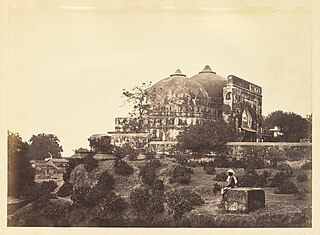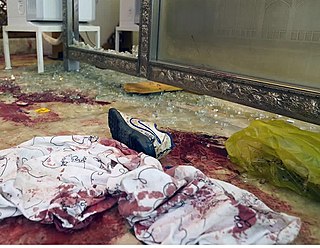
Babri Masjid was a mosque in Ayodhya, India, which many Hindus believe was built upon the site of Ram Janmabhoomi, the hypothesized birthplace of Rama, a principal deity of Hinduism. It has been a focus of dispute between the Hindu and Muslim communities since the 18th century. According to the mosque's inscriptions, it was built in 1528–29 by Mir Baqi, a commander of the Mughal emperor Babur. The mosque was attacked and demolished by a Hindu nationalist mob in 1992, which ignited communal violence across the Indian subcontinent.

Mashhad, also spelled Mashad, was the capital of Persia during the Afsharid dynasty by Nader Afshar and now is the second-most-populous city in Iran, located in the relatively remote north-east of the country about 900 kilometres from Tehran. Falling in the Central District of Mashhad County, it serves as the capital of Razavi Khorasan Province and has a population about 3,400,000, which includes the areas of Mashhad Taman and Torqabeh.

Ali al-Husayni al-Sistani, is a Twelver Shia Iranian–Iraqi Grand Ayatollah and marja'. One of the most senior scholars in Shia Islam, he has been described as the spiritual leader of Shia Muslims worldwide, "the undisputed leader of Iraq's Shias", included in top positions of "The Muslim 500: The World's Most Influential Muslims", from 2009 to 2023, and named one of the 100 most influential people in the world by Time magazine in 2004 and 2005.

Jannat al-Baqīʿ is the oldest and the first Islamic cemetery of Medina in the Hejazi region of present-day Saudi Arabia. It is also known as Baqīʿ al-Gharqad.

The vast majority of people in Kyrgyzstan are Muslims; as of 2020, 90% of the country's population were followers of Islam. Muslims in Kyrgyzstan are generally of the Sunni branch, mostly of the Hanafi school, which entered the region during the eighth century. Most Kyrgyz Muslims practice their religion in a specific way influenced by shamanic tribal customs. There has been a revival of Islamic practices since independence in Kyrgyzstan. For the most part religious leaders deal only with issues of religion and do not reach out to communities, but rather offer services to those who come to the mosque. There are regional differences, with the southern part of the country being more religious. Kyrgyzstan remained a secular state after the fall of communism, which had only superficial influence on religious practice when Kyrgyzstan was a Soviet republic, despite the policy of state atheism. Most of the Russian population of Kyrgyzstan is Russian Orthodox. The Uzbeks, who make up 14.9 percent of the population, are generally Sunni Muslims.

Islam is the official religion of the United Arab Emirates. Of the total population, 76.9% are Muslims as of a 2010 estimate by the Pew Research Center. Although no official statistics are available for the breakdown between Sunni and Shia Muslims among noncitizen residents, media estimates suggest less than 20 percent of the noncitizen Muslim population are Shia.

Islam is the majority religion in Azerbaijan, but the country is considered to be the most secular in the Muslim world. Various reports have estimated 97.3% or 99.2% of the population identifying as Muslim; with the majority being adherents of the Shia branch (55-85%), while a significant minority (15-45%) are Sunnis. Traditionally, the differences between these two branches of Islam have not been sharply defined in Azerbaijan.
Islam entered Iran with the Muslim conquest (637–651) and led to the end of the Sasanian Empire and the eventual decline of the Zoroastrian religion in Iran (Persia). Since its establishment after the 7th-century conquest, Islam has remained the state religion of Iran except for during a short period after the Mongol invasions and subsequent establishment of the Ilkhanate in the 13th century. Following the Muslim conquest, there was a slow but steady movement of the population toward Islam, despite notable resistance, with nobility and city-dwellers being the first to convert, and the peasantry and the dehqans, or land-owning magnates slower to do so. By the 10th century, the majority of Persians had become Muslims.

Razavi Khorasan or Central Khorasan Province is one of the 31 provinces of Iran, located in northeastern Iran. The city of Mashhad is the center and capital of the province. Central Khorasan is one of the three provinces that were created after the division of Khorasan province in 2004. In 2014, it was placed in Region 5 with Mashhad as the location of the region's secretariat.
Torbat-e Jam is a city in the Central District of Torbat-e Jam County, Razavi Khorasan province, Iran, serving as capital of both the county and the district. It is one of the ancient cities of Greater Khorasan.

A mazār, also transliterated as mazaar, also known as marqad (مَرْقَد) or in the Maghreb as ḍarīḥ (ضَرِيْح), is a mausoleum or shrine in some places of the world, typically that of a saint or notable religious leader. Medieval Arabic texts may also use the words mašhad (مَشْهَد) or maqām to denote the same concept.
After the death of Muhammad in 632, a group of Muslims, who would come to be known as the Sunnis, believed that Muhammad's successor as caliph of the Islamic community should be Abu Bakr, whereas a second group of Muslims, who would come to be known as the Shias, believed that his successor should have been Ali. This dispute spread across various parts of the Muslim world, which eventually led to the Battle of Jamal and Battle of Siffin. Sectarianism based on this historic dispute intensified greatly after the Battle of Karbala, in which Husayn ibn Ali and some of his close partisans, including members and children of the household of prophet, were killed by the ruling Umayyad Caliph Yazid I, and the outcry for revenge divided the early Islamic community, albeit disproportionately, into two groups, the Sunni and the Shia. This is known today as the Islamic schism.
Religion in Iran has been shaped by multiple religions and sects over the course of the country's history. Zoroastrianism was the main followed religion during the Achaemenid Empire, Parthian Empire, and Sasanian Empire. Another Iranian religion known as Manichaeanism was present in Iran during this period. Jewish and Christian communities thrived, especially in the territories of northwestern, western, and southern Iran—mainly Caucasian Albania, Asoristan, Persian Armenia, and Caucasian Iberia. A significant number of Iranian peoples also adhered to Buddhism in what was then eastern Iran, such as the regions of Bactria and Sogdia.
The Constitution of Bahrain states that Islam is the official religion and that Shari'a is a principal source for legislation. Article 22 of the Constitution provides for freedom of conscience, the inviolability of worship, and the freedom to perform religious rites and hold religious parades and meetings, in accordance with the customs observed in the country; however, the Government has placed some limitations on the exercise of this right.

The destruction of heritage sites associated with early Islam is an ongoing phenomenon that has occurred mainly in the Hejaz region of western Saudi Arabia, particularly around the two holiest cities of Islam, Mecca and Medina. The demolition has focused on mosques, burial sites, homes and historical locations associated with the Islamic prophet Muhammad, his companions, and many of the founding personalities of early Islamic history by the Saudi government. In Saudi Arabia, many of the demolitions have officially been part of the continued expansion of the Masjid al-Haram at Mecca and the Prophet's Mosque in Medina and their auxiliary service facilities in order to accommodate the ever-increasing number of Muslims performing the pilgrimage (hajj).
The Saudi government does not conduct a census on religion or ethnicity, but some sources estimate the Shia population in Saudi Arabia to make up around 20% of the approximately 34 million natives of Saudi Arabia.

During the 2011 Bahraini uprising, as many as 43 Shia mosques and tens of other religious structures including graves, shrines and hussainiyas were intentionally destroyed or damaged by the ruling Sunni Bahraini authorities in the country. The widespread action in Shiite villages across this island was seen as part of a government crackdown on Shiite dissidents, although Bahrain's Minister of Justice and Islamic Affairs, Sheikh Khalid bin Ali bin Abdulla al Khalifa, claimed that only mosques illegally built without permission had been targeted.

The Grand Makki Mosque of Zahedan is the largest Sunni mosque in Iran and is located in the center of Zahedan, the capital of the province Sistan and Baluchestan.

The al-Sayyida Nafisa Mosque is a mosque in al-Sayyida Nafisa district, a section of the larger historic necropolis called al-Qarafa in Cairo, Egypt. It is built to commemorate Sayyida Nafisa, an Islamic saint and member of the family of the Islamic prophet Muhammad. The mosque contains her mausoleum, also known as a mashhad. She was the great-granddaughter of Hasan, one of the Prophet Muhammad's two grandsons. Along with the necropolis around it, the mosque is listed as part of the UNESCO World Heritage Site of Historic Cairo.

The Shah Cheragh attack was a terrorist attack that occurred on 26 October 2022 at Shah Cheragh mosque, a Shia pilgrimage site in Shiraz in southern Iran, in which at least 13 people were killed.


























